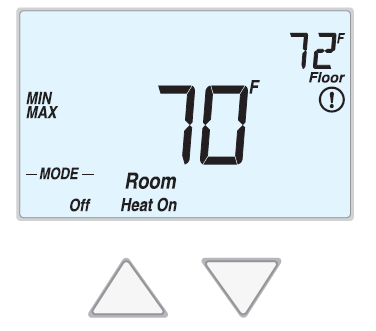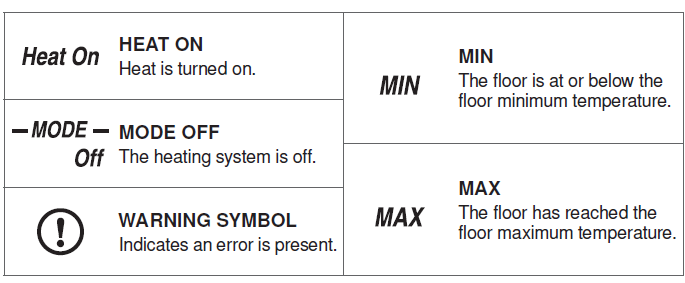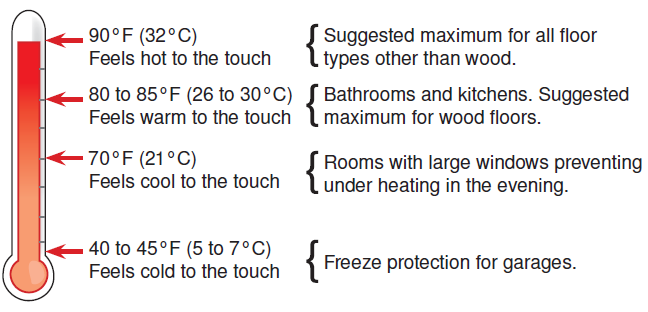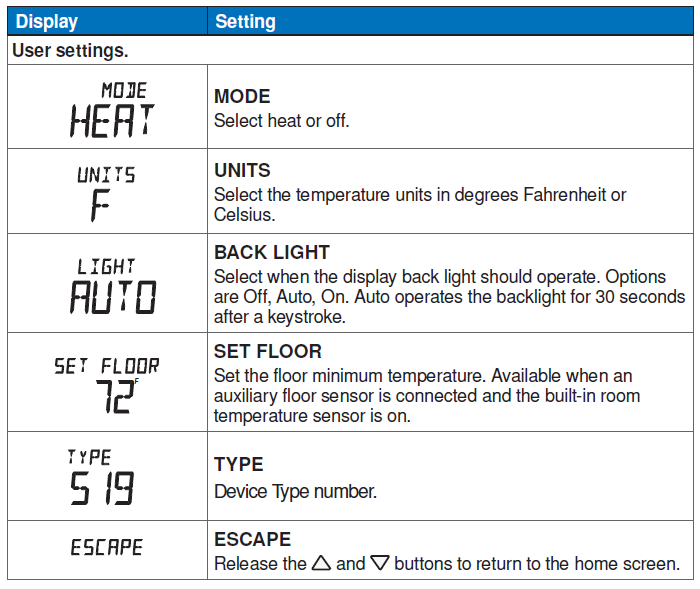tekmar 519_U Radiant Thermostat

This brochure will provide you with the information you need to benefit the most from your tekmar Thermostat. Please visit www.tekmarControls.com for more detailed information on this or any other tekmar product.
User Interface

Display Symbols
This thermostat will display symbols on its screen in order to indicate what mode it is in, what temperature it is operating at, or what equipment it is trying to turn on. This section describes each of those symbols.

Setting The Temperature
To change the heat temperature setting, push the![]() or
or ![]() buttons to select a preferred temperature setting.
buttons to select a preferred temperature setting.
Air Temperature Only
If there is only an air temperature sensor (no floor sensor), the thermostat operates to control your desired air temperature.
Floor Temperature Only
If the air sensor has been disabled, the thermostat will only maintain floor temperature and ignore air temperature. This operation is recommended for areas such as bathrooms to ensure that tile floors are warm to the touch.
Floor and Air Temperature
If the air sensor is turned on and a floor sensor is connected, the thermostat will maintain your desired air temperature as well as a minimum floor temperature. This operation is recommended for areas with large windows that allow the sun to shine into a room and keep it warm without the need for heat. This can allow the floors to cool off during the afternoon. When the sun goes down, it can take a long time for the floors to get warm again. This may cause the room to cool off too much in the early evening. A floor minimum setting can help with this condition by maintaining a floor minimum temperature. Keep in mind the floor minimum temperature will override the air temperature, and if set too high, may overheat the room.
This operation is also recommended for rooms with hardwood floors. Setting floor minimum and maximum temperatures is a way of enhancing the comfort of your living space while protecting your floor coverings.

Settings
- Press and hold down both
 buttons
buttons for 3 seconds to change from one step to the next.
for 3 seconds to change from one step to the next. - Release both buttons once the step has been reached.
- Press
 or
or  the button to change the setting, if available.
the button to change the setting, if available. - Press and hold down both
 the
the and buttons for 3 seconds to go to the next step, OR
and buttons for 3 seconds to go to the next step, OR - After 15 seconds of no button activity, the display goes back to normal operation.

More Information
This User Brochure contains standard information on how to make adjustments to an installed product. More detailed information can be found in this product’s Installation and Operation Manual (519_D) at www.tekmarControls.comProduct design, software, and literature are Copyright ©2013 by tekmar Control Systems Ltd., A Watts Water Technologies Company. Head Office: 5100 Silver Star Road, Vernon, B.C. Canada V1B 3K4, 250-545-7749, Fax. 250-545-0650 Web Site: www.tekmarControls.com All specifications are subject to change without notice.
Reference:
Download Manual:
tekmar 519_U Radiant Thermostat User Manual


Leave a Reply